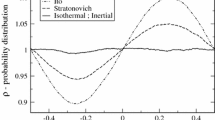Abstract
We revisit the one-dimensional Burgers equation in the inviscid limit for white-noise initial velocity. We derive the probability distributions of velocity and Lagrangian increments, measured on intervals of any length x. This also gives the velocity structure functions. Next, for the case where the initial density is uniform, we obtain the distribution of the density, over any scale x, and we derive the density two-point correlation and power spectrum. Finally, we consider the Lagrangian displacement field and we derive the distribution of increments of the Lagrangian map. We check that this gives back the well-known mass function of shocks. For all distributions we describe the limiting scaling functions that are obtained in the large-scale and small-scale limits. We also discuss how these results generalize to other initial conditions, or to higher dimensions, and make the connection with a heuristic multifractal formalism. We note that the formation of point-like masses generically leads to a universal small-scale scaling for the density distribution, which is known as the “stable-clustering ansatz” in the cosmological context (where the Burgers dynamics is also known as the “adhesion model”).
Similar content being viewed by others
References
Aurell, E., Frisch, U., Noullez, A., Blank, M.: Bifractality of the devil’s staircase appearing in the Burgers equation with Brownian initial velocity. J. Stat. Phys. 88, 1151–1164 (1997)
Avellaneda, M.: Statistical properties of shocks in Burgers turbulence II: tail probabilities for velocities, shock-strengths and rarefaction intervals. Commun. Math. Phys. 169, 45–59 (1995)
Avellaneda, M., Weinan, E.: Statistical properties of shocks in Burgers turbulence. Commun. Math. Phys. 172, 13–38 (1995)
Balian, R., Schaeffer, R.: Scale-invariant matter distribution in the universe. II—Bifractal behaviour. Astron. Astrophys. 226, 373–414 (1989)
Bec, J., Khanin, K.: Burgers turbulence. Phys. Rep. 447, 1–66 (2007)
Bertoin, J.: The inviscid Burgers equation with Brownian initial velocity. Commun. Math. Phys. 193, 397–406 (1998)
Burgers, J.M.: The Nonlinear Diffusion Equation. Reidel, Dordrecht (1974)
Cole, J.D.: On a quasi-linear parabolic equation occurring in aerodynamics. Quart. Appl. Math. 9, 225–236 (1951)
Colombi, S., Bouchet, F.R., Hernquist, L.: Self-similarity and scaling behavior of scale-free gravitational clustering. Astrophys. J. 465, 14 (1996)
Davis, M., Peebles, P.J.E.: On the integration of the BBGKY equations for the development of strongly nonlinear clustering in an expanding universe. Astrophys. J. Suppl. Ser. 34, 425–450 (1977)
Fournier, J.-D., Frisch, U.: L’equation de Burgers deterministe et statistique. J. Mech. Theor. Appl. 2, 699–750 (1983)
Frachebourg, L., Martin, Ph.A.: Exact statistical properties of the Burgers equation. J. Fluid Mech. 417, 323–349 (2000)
Frisch, U.: Turbulence. Cambridge University Press, Cambridge (1995)
Frisch, U., Bec, J.: Burgulence. In: Lesieur, M., Yaglom, A., David, F. (eds.) Les Houches 2000: New Trends in Turbulence. Springer, Berlin (2001)
Groeneboom, P.: Brownian motion with a parabolic drift and airy functions. Probab. Theory Related Fields 81, 79–109 (1989)
Gurbatov, S.N., Malakhov, A., Saichev, A.: Nonlinear Random Waves and Turbulence in Nondispersive Media: Waves, Rays and Particles. Manchester University Press, Manchester (1991)
Gurbatov, S.N., Saichev, A.I., Shandarin, S.F.: The large-scale structure of the universe in the frame of the model equation of non-linear diffusion. Mont. Not. R. Astron. Soc. 236, 385–402 (1989)
Gurbatov, S.N., Simdyankin, S.I., Aurell, E., Frisch, U., Toth, G.: On the decay of Burgers turbulence. J. Fluid Mech. 344, 339–374 (1997)
Hopf, E.: The partial differential equation u t +uu x =u xx . Commun. Pure Appl. Math. 3, 201–230 (1950)
Kida, S.: Asymptotic properties of Burgers turbulence. J. Fluid Mech. 93, 337–377 (1979)
Kraichnan, R.H.: Lagrangian-history statistical theory for Burgers’ equation. Phys. Fluids 11, 265–277 (1968)
Le Doussal, P.: Exact results and open questions in first principle functional RG. arXiv:0809.1192 (2008)
Melott, A.L., Shandarin, S.F., Weinberg, D.H.: A test of the adhesion approximation for gravitational clustering. Astrophys. J. 428, 28–34 (1994)
Molchan, G.M.: Burgers equation with self-similar Gaussian initial data: tail probabilities. J. Stat. Phys. 88, 1139–1150 (1997)
Noullez, A., Gurbatov, S.N., Aurell, E., Simdyankin, S.I.: Global picture of self-similar and non-self-similar decay in Burgers turbulence. Phys. Rev. E 71, 056305 (2005)
Peacock, J.A., Dodds, S.J.: Non-linear evolution of cosmological power spectra. Mon. Not. R. Astron. Soc. 280, L19–L26 (1996)
Peebles, P.J.E.: The Large Scale Structure of the Universe. Princeton University Press, Princeton (1980)
She, Z.-S., Aurell, E., Frisch, U.: The inviscid Burgers equation with initial data of Brownian type. Commun. Math. Phys. 148, 623–641 (1992)
Sinai, Ya.G.: Statistics of shocks in solutions of inviscid Burgers equation. Commun. Math. Phys. 148, 601–621 (1992)
Tribe, R., Zaboronski, O.: On the large time asymptotics of decaying Burgers turbulence. Commun. Math. Phys. 212, 415–436 (2000)
Valageas, P.: Non-linear gravitational clustering: smooth halos, substructures and scaling exponents. Astron. Astrophys. 347, 757–768 (1999)
Valageas, P.: Using the Zeldovich dynamics to test expansion schemes. Astron. Astrophys. 476, 31–58 (2007)
Valageas, P.: Quasi-linear regime and rare-event tails of decaying Burgers turbulence. Phys. Rev. E 80, 016305 (2009)
Valageas, P.: Statistical properties of the Burgers equation with Brownian initial velocity. J. Stat. Phys. 134, 589 (2009)
Vergassola, M., Dubrulle, B., Frisch, U., Noullez, A.: Burgers’ equation, devil’s staircases and the mass distribution for large-scale structures. Astron. Astrophys. 289, 325–356 (1994)
Vogelsberger, M., White, S.D.M., Helmi, A., Springel, V.: The fine-grained phase-space structure of cold dark matter haloes. Mon. Not. R. Astron. Soc. 385, 236–254 (2008)
Zeldovich, Y.B.: Gravitational instability: an approximate theory for large density perturbations. Astron. Astrophys. 5, 84–89 (1970)
Author information
Authors and Affiliations
Corresponding author
Rights and permissions
About this article
Cite this article
Valageas, P. Some Statistical Properties of the Burgers Equation with White-Noise Initial Velocity. J Stat Phys 137, 729–764 (2009). https://doi.org/10.1007/s10955-009-9809-y
Received:
Accepted:
Published:
Issue Date:
DOI: https://doi.org/10.1007/s10955-009-9809-y



